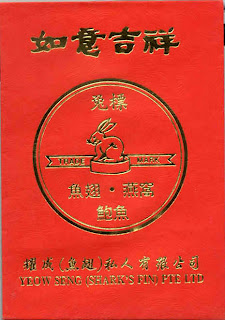The story of "Ang Pow" (or "Red Packet", "Hong Bao" or "Lai See") dates back to the Sung Dynasty in China. A village called Chang-Chieu was at the time terrorized by a huge, evil demon, and no one was capable of defeating it. Not even their greatest warriors or statesmen.
However, a young orphan, armed with a magical saber inherited from his ancestors, fought the demon and eventually killed it. The villagers were so grateful, the elders presented the brave young man with a red packet filled with money as a reward for his courage.
Since then, the ang pow has become a part of traditional Chinese custom.
Ang Pows are now used during Chinese New Year, Birthdays, Funerals (white ones), and of course: Weddings. Almost anything can be stuffed into an Ang Pow, from cash to checks, and even jewelry. In Singapore, the tradition is for guests attending the wedding to come bearing Ang Pows for the newlywed couple instead of gifts. A little congratulatory note is sometimes written on the back, and signed by the giver.
From: timandlisa2008.com
Thursday, April 1, 2010
Bliss and Dan: a wedding reception
Regarding Gifts: Emily who?
So as you can see, gifts would be difficult, and ultimately the thought and time put into purchasing a gift would in some way end up being wasted.
We are afraid that we can't subscribe to proper Emily Post wedding etiquette, and ask that you'll be understanding in our decision to adopt a tradition more in the spirit of a Chinese wedding and Chinese New Year, as the reception will actually be happening on Chinese New Years Eve. While your presence at our reception is all we ask for, if you would like to give a gift, we ask that it comes in the form of a hong bao, or red envelope. While a hong bao in Chinese tradition typically involves money, we understand that Western traditionalists would simply find this practice in bad taste. We would love to see what some of you come up with for your hong bao. Don't be afraid to be creative, many things other than money can fit in an envelope.
But really, the best gift by far would be having the opportunity to see you at the reception in February. It's coming up soon!
From: blissanddan.com
Mr.Data Hong Bao Collection
Giving a Hong Bao is a Chinese tradtion that happens during Chinese New Year. I have been giving and getting Hong Baos for a while now (my son gets most of them). It is an interesting Chinese tradition that gets to the root of the issue of gift giving. In the west, we tend to give gifts, which are often exchanged as almost like a gift voucher for what the receiver really wanted (Especially when getting older after childhood, where we find that we don't have the slightest idea what to get the other party).
While surfing, I found this web page that has the following good explanation:
Next to Mandarin oranges, the most popular feature of Chinese New Year is the giving of hong bao (red packets). Red is an important colour to the Chinese because it symbolises life, happiness and good luck. (In contrast black is associated with death and Chinese generally shun this colour on festive and joyous occasions.) Hong Bao
The custom of giving hongbao to the young (by Chinese definition only those who are married are considered adults), signifies the transmission of good wishes and good fortune. The money inserted in the hongbao is intended only to give a little joy to the young recipient; more important is the expression of good fortune represented by the red paper. It is therefore considered rude for the recipients to open their hongbao in front of the givers.
This is a collection of Hong Baos received during Chinese New Year, 1997
1998
Collected in 2001 from 1999, 2000
While surfing, I found this web page that has the following good explanation:
Next to Mandarin oranges, the most popular feature of Chinese New Year is the giving of hong bao (red packets). Red is an important colour to the Chinese because it symbolises life, happiness and good luck. (In contrast black is associated with death and Chinese generally shun this colour on festive and joyous occasions.) Hong Bao
The custom of giving hongbao to the young (by Chinese definition only those who are married are considered adults), signifies the transmission of good wishes and good fortune. The money inserted in the hongbao is intended only to give a little joy to the young recipient; more important is the expression of good fortune represented by the red paper. It is therefore considered rude for the recipients to open their hongbao in front of the givers.
This is a collection of Hong Baos received during Chinese New Year, 1997
1998
Collected in 2001 from 1999, 2000
Subscribe to:
Comments (Atom)





























































